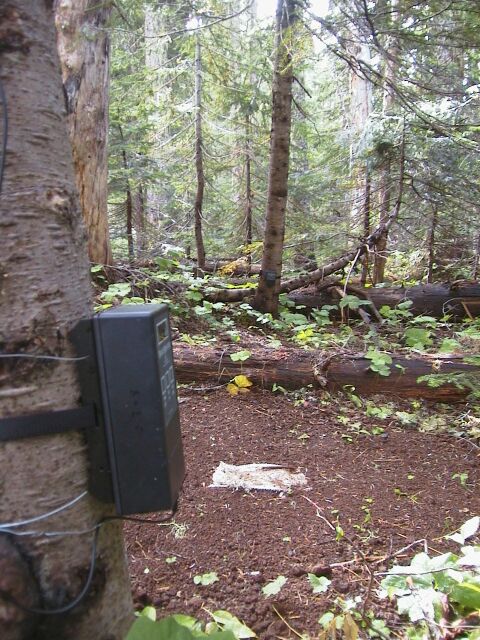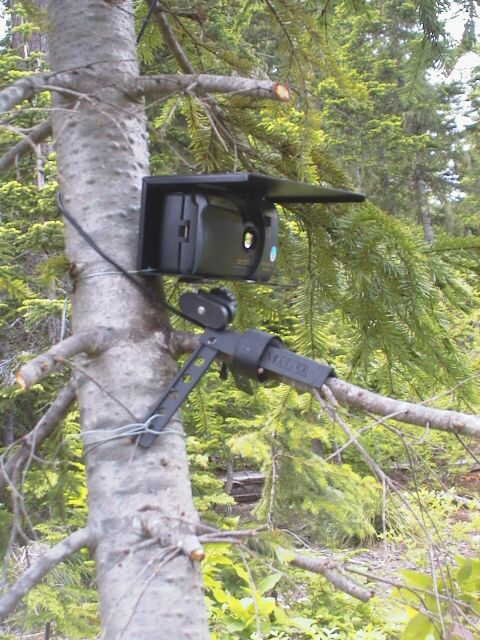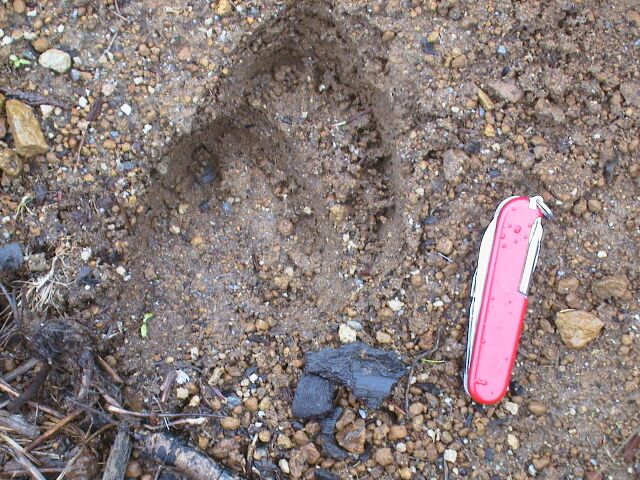


Location. Gifford Pinchot Forest (southern Washington between Mt. St. Helens and Mt. Adams).
Purpose.Determine presence of any gray wolf in the study area.
Participants. Four teams of volunteer trackers from Portland, Stevenson, Hood River, and Olympia.
Camera Protocol. Each team took responsibility for setting up and monitoring a camera site. Each dual sensor camera unit consisted of a transmitter, a programmable receiver, and an inexpensive point-and-shoot. First a team member hung a piece of carpet impregnated with a call scent high in a tree. Second the team removed vegetation to create a clearing approximately 8 feet in diameter of vegetation to serve as a "track trap." Tne preparer raked the surface to remove all debris and create a layer of fine earth, sand, or dust to record the tracks of any animal crossing the area. The preparer spiked a small piece of carpet impregnated with a scent lure (coyote lure and beaver castor) into the ground in the center of the clearing. Tacks were pressed into the carpet to snag a hair sample if a wolf rolled on the scented carpet. Third, the team arranged the transmitter and receiver about two feet off the ground with the beam aimed across the scent lure and attached leads to a camera pointing at the track trap. Any animal of sufficient height walking up to the scent lure would trigger the camera. The team inspected the site at least every other week. Camera batteries were replaced each month.


Track Trap Protocol. To supplement the camera sites, two teams added ten more sites consisting only of the call scent and a track trap. Track trap sites were easy to set up but required weekly visits to maintain the track trap and record any tracks. The intent of the track traps was to increase the area sampled and to identify promising camera sites.
Recordkeeping Protocol. Brent Foster developed a comprehensive set of forms for recording camera activity, tracks, scat, and other sign.
Training.Jack Laufer, a biologist from Wolf Haven in Tenino, provided an introduction to wolf identification, behavior, and conservation. Sarah Lamar, a Fish and Wildlife biologist, trained volunteers in the use of dual sensor cameras on loan from the Forest Service. Brent Foster introduced the recordkeeping protocol.
 After modification of the protocol and the addition of 10 track trap sites, two teams were successful
in attracting a variety of carnivore including coyote, fox, cougar, and bear to track traps. The group
learned much about conducting such a census during the process and developed recommendations to guide
future efforts.
After modification of the protocol and the addition of 10 track trap sites, two teams were successful
in attracting a variety of carnivore including coyote, fox, cougar, and bear to track traps. The group
learned much about conducting such a census during the process and developed recommendations to guide
future efforts.
Several events provided some incentive to continue census efforts in the Gifford Pinchot. One camera site yielded mysterious feline tracks that suggested lynx but unfortunately the camera was not triggered and the tracks were inconclusive. So far, anecdotal reports of wolf sightings and howls in one area covered by the census remain unconfirmed.
Photo top right: Track trap and camera receiver.
Photo middle left: Close up of camera in position.
Photo middle right: Alignment of transmitter and receiver.
Photo bottom right: Example of elk tracks in track trap.